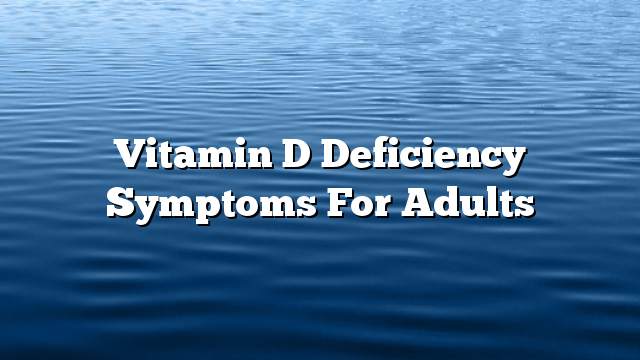Vitamin D
Vitamin D is a fat soluble vitamin, also called the sun’s vitamin, because it is made inside the body when exposed to ultraviolet light. However, nearly 50% of the world’s population is not exposed to sunlight. Vitamin D deficiency is very common. It is estimated that about one billion people worldwide have low vitamin D levels.
Symptoms of vitamin D deficiency in adults
Most people do not realize that they are deficient in vitamin D, because the symptoms are often subtle and unspecified, and can not be easily observed. Symptoms of vitamin D deficiency in adults include:
- Infection and infection frequently: Vitamin D plays a major role in maintaining the strength of the immune system, thus it helps the body to fight viruses and bacteria that cause diseases, especially respiratory infections; colds, bronchitis, and pneumonia.
- Stress and fatigue: A combination of factors causes a constant feeling of fatigue. Vitamin D deficiency is one of the causes of stress and fatigue and is often overlooked as a possible cause.
- Bone and back pain: Vitamin D helps maintain bone health by improving the body’s ability to absorb calcium; chronic back pain that limits daily activities is associated with low vitamin D levels in the body.
- Depression: Vitamin D deficiency is associated with depression, including seasonal depression during winter months, especially in older people.
- Difficulty healing wounds: The slow recovery of wounds after surgery or injuries can indicate very low levels of vitamin D. Vitamin D helps to increase the production of compounds responsible for the formation of new skin as part of wound healing, and plays a key role in controlling infections and infections during Period of wound healing.
- Hair loss: Hair loss is often attributed to stress and stress. However, when hair loss is severe in females, it may be due to illness or lack of nutrients, such as vitamin D deficiency.
- Pain and muscle weakness: It is often difficult to determine the causes of muscle pain. Chronic muscle pain in children and adults can be caused by low vitamin D levels.
- Weakness of perception in adults
Vitamin D deficiency is closely linked to a range of diseases and health problems, including:
- Osteoporosis, and osteoporosis.
- cancer.
- Cardiovascular diseases.
Vitamin D also plays an important role in preventing a range of health conditions, including type 1 and type 2 diabetes, high blood pressure, glucose intolerance, and multiple sclerosis.
Causes of vitamin D deficiency
A person may be exposed to vitamin D deficiency for several reasons, including:
- A strict vegetarian diet.
- Overweight, or obesity.
- Live away from the equator.
- Use sunscreen permanently when you go out ..
- Dark skin, as melanin reduces the ability of the skin to make vitamin D when exposed to sunlight.
- The inability of the kidneys to convert vitamin D to its active form, as the kidney becomes less able to convert vitamin D to its active form, increasing the risk of vitamin D deficiency.
- The inability of the digestive system to absorb vitamin D from food. Some diseases and medical conditions affect the absorption of vitamin D, including Crohn’s disease, cystic fibrosis, Celiac disease.
Check for Vitamin D deficiency
The 25-hydroxy vitamin D test is the most accurate method for measuring the level of vitamin D in the body. The level of 20 ng / ml to 60 ng / ml is normal for healthy people. If the level is less than 12 ng / mL, To vitamin D deficiency.
Sources of Vitamin D
There are three sources of vitamin D:
- Exposure to sunlight : Most people get vitamin D amounts by exposure to the sun, so 5-30 minutes of exposing the face, arms, legs or back to the sun between 10am and 3pm at least twice a week – Sunscreen – enough to cover the body’s needs of vitamin D. People who can not get enough sunlight need their diets to include vitamin D-rich sources or to take vitamin D supplements. UV rays do not penetrate the glass, so exposure to sunlight from behind a window does not allow vitamin D production. A combination of factors influences vitamin D production when exposed to sunlight, including:
- Chapter of the year.
- Exposure time to the sun.
- Cloud cover, and smog.
- The amount of melanin pigment in the skin.
- the food : Very few foods naturally contain vitamin D, and there are some foods that are supported by vitamin D. These include:
- Fatty fish, such as: salmon, tuna, and mackerel, are considered fatty fish from the best sources of vitamin D.
- Cow liver, cheese, egg yolks, and these sources contain very low amounts of vitamin D.
- Foods fortified with vitamin D, such as milk, orange juice, and fortified grains.
- Vitamin D tablets .
